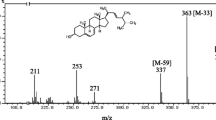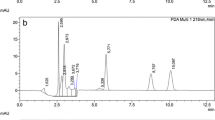Abstract
Liquid chromatography coupled with tandem mass spectrometric detection has gained more importance for mycotoxin determination in recent years. In addition to instrumental improvements, the development of LC-MS-MS has also been a consequence of the availability of stable isotope internal standards, e.g., 13C-labelled mycotoxins. Thus, the LC-ESI-MS-MS method using a 13C15-deoxynivalenol internal standard as a state-of-the-art technique was selected as a reference procedure for an in-house method comparison study of the determination of deoxynivalenol (DON) in wheat materials. Alternative methods include LC-diode array detection, which is a frequently used routine procedure for DON-analysis, and gas chromatography after trimethylsilylation. For GC application, an electron capture detector and a negative chemical ionisation mass spectrometry detector were used, which have both been well described in the literature. The method comparison was conducted using t test statistics. Additionally, this study also calculates important method performance characteristics, including accuracy, linearity, limit of detection, limit of quantification, recovery, and variation coefficient. Furthermore, this is the first report of a GC-MS method for the determination of DON using a fully carbon-labelled 13C15-DON as an IS. The GC-MS using 13C15-DON as an IS has produced comparable results to the 13C-IS-LC-MS-MS reference method with a similar sensitivity. ECD detection was slightly less sensitive, but is also suited for DON analysis in wheat. Due to the high LOQ, the LC-DAD method seems highly applicable to the measurement of highly contaminated samples.


Similar content being viewed by others
References
Communication regulation 2005/856/CE amending regulation 466/2001/CE as regards fusarium toxins. Off J Eur Commun 2005; L 143/3
Langseth W, Runderberg T (1998) J Chromatogr A 815:103–121. doi:10.1016/S0021-9673(98)00388-4
Klötzel M, Schmidt S, Lauber U, Thielert G, Humpf HU (2005) Chromatographia 62:41–48. doi:10.1365/s10337-005-0576-x
Jiménez M, Mateo JJ, Mateo R (2000) J Chromatogr A 870:473–481. doi:10.1016/S0021-9673(99)00890-0
Sano A, Matsutani S, Suzuki M, Takitani S (1987) J Chromatogr A 410:427–436. doi:10.1016/S0021-9673(00)90072-4
Krska R, Baumgartner S, Josephs R (2001) Fresenius J Anal Chem 371:285–299. doi:10.1007/s002160100992
Razzazi-Fazeli E, Böhm J, Luf W (1999) J Chromatogr A 854:45–55. doi:10.1016/S0021-9673(99)00616-0
Royer D, Humpf HU, Guy A (2004) Food Addit Contam 21:678–692. doi:10.1080/02652030410001711304
Berthiller F, Schuhmacher R, Buttinger G, Krska R (2005) J Chromatogr A 1062:209–216. doi:10.1016/j.chroma.2004.11.011
Gentili A, Caretti F, D’Ascenzo G, Rocca LM, Marchese S, Materazzi S, Perret D (2007) Chromatographia 66:669–676. doi:10.1365/s10337-007-0411-7
Biselli S, Hummert C (2005) Food Addit Contam 22:752–760. doi:10.1080/02652030500158617
Razzazi-Fazeli E, Böhm J, Jarukamjorn K, Zentek J (2003) J Chromatogr B Anal Technol Biomed Life Sci 796:21–33. doi:10.1016/S1570-0232(03)00604-4
Häubl G, Berthiller F, Rechthaler J, Jaunecker G, Binder EM, Krska R, Schuhmacher R (2006) Food Addit Contam 23:1187–1193. doi:10.1080/02652030600654390
Gilbert J (2000) Nat Toxins 7:347–352. doi:10.1002/1522-7189(199911/12)7:6<347::AID-NT78>3.0.CO;2-P
Krska R, Molinelli A (2007) Anal Bioanal Chem 387:145–148. doi:10.1007/s00216-006-0797-3
Schwadorf K (2006) http://www.lachemie.uni-hohenheim.de/fumi/schwador/publi-b.html. Accessed May 2008
Langseth W, Bernhoft A, Runderberg T, Kosiak B, Gareis M (1999) Mycopathologia 144:103–113. doi:10.1023/A:1007016820879
Blaas W, Kellert M, Steinmeyer S, Tiebach R, Weber R (1984) Z Lebensm Unters Forsch 179:104–108. doi:10.1007/BF01043259
Häubl G, Berthiller F, Krska R, Schuhmacher R (2006) Anal Bioanal Chem 384:692–696. doi:10.1007/s00216-005-0218-z
Author information
Authors and Affiliations
Corresponding author
Rights and permissions
About this article
Cite this article
Neuhof, T., Ganzauer, N., Koch, M. et al. A Comparison of Chromatographic Methods for the Determination of Deoxynivalenol in Wheat. Chroma 69, 1457–1462 (2009). https://doi.org/10.1365/s10337-009-1084-1
Received:
Revised:
Accepted:
Published:
Issue Date:
DOI: https://doi.org/10.1365/s10337-009-1084-1




